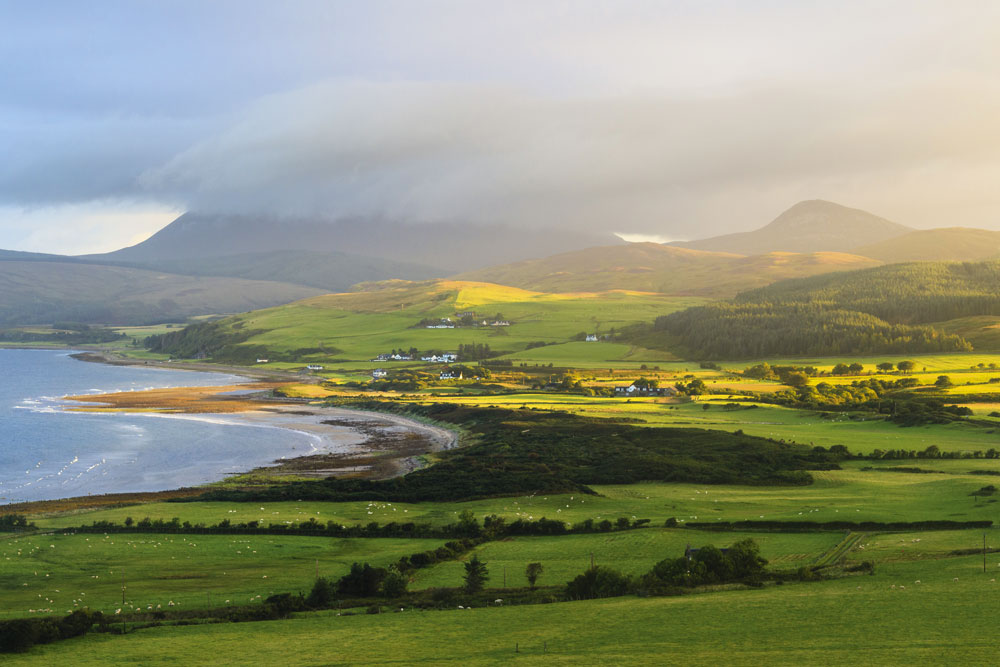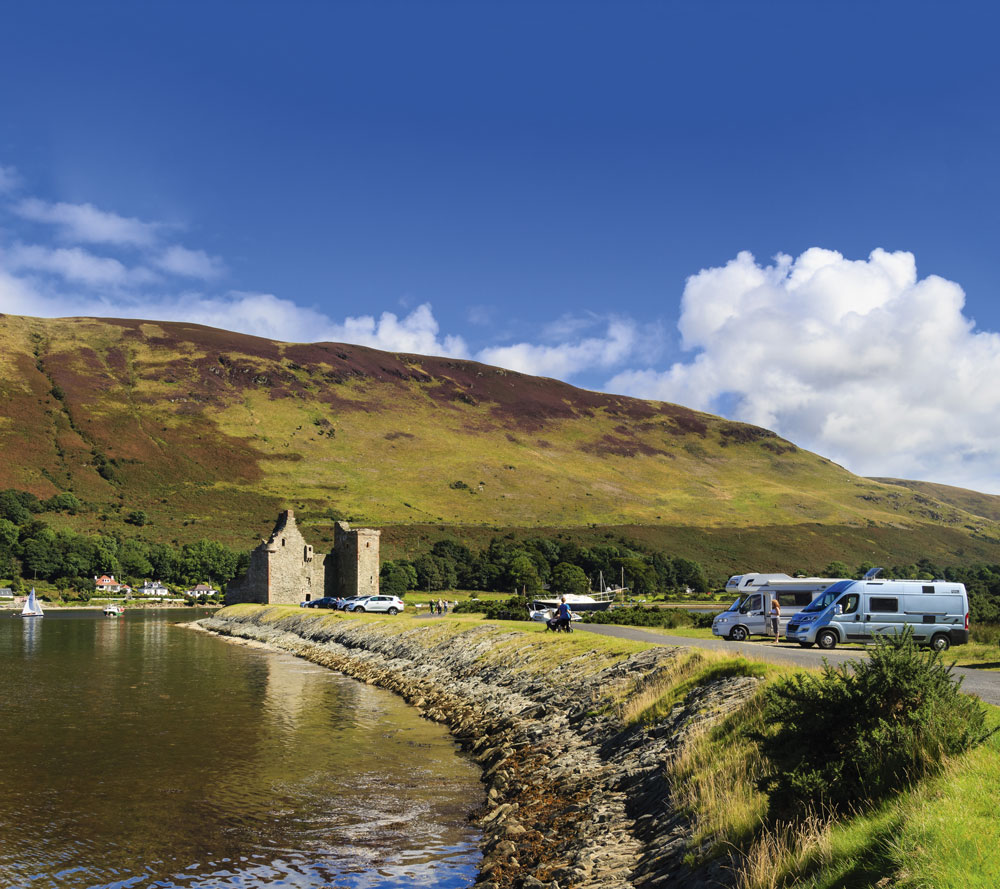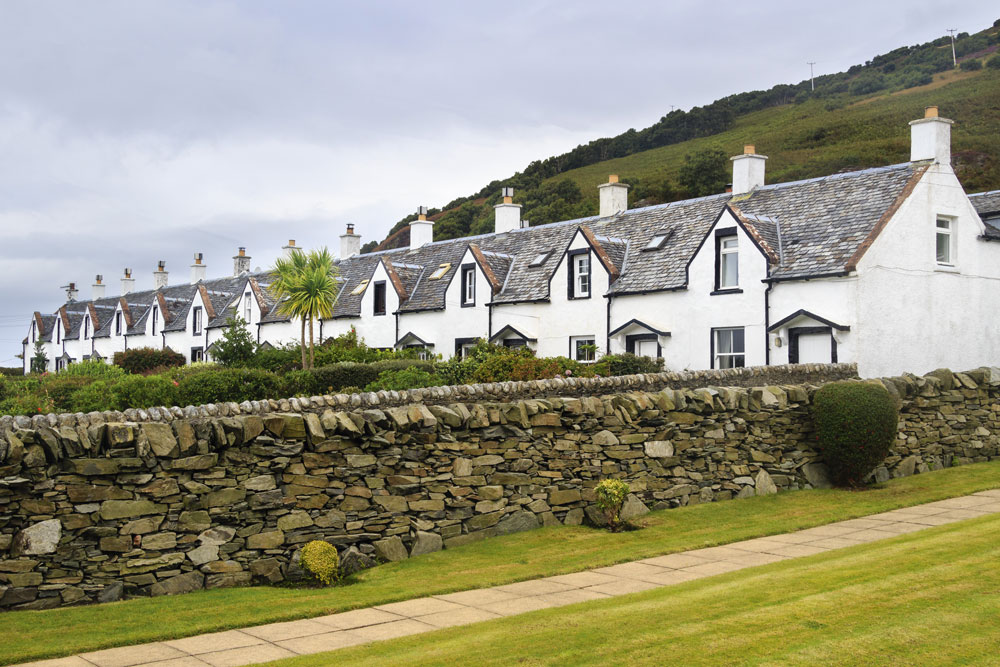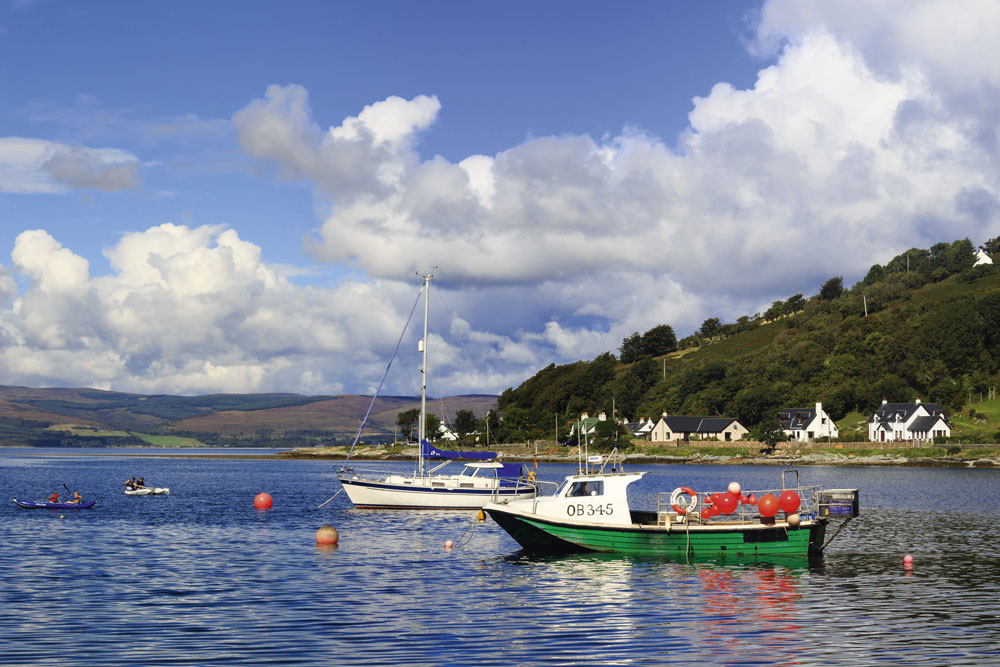Motorhome travel: Enchanting Arran
Words and photos: Felicity Martin
Arran is one of Scotland’s most accessible islands, only a 55-minute ferry from Ardrossan, which is about an hour’s drive south of Glasgow on the Ayrshire coast. It is often described as Scotland in miniature because you can find everything that the country is famous for here: stunning scenery, amazing wildlife, ancient history, rich culture and great food.
I anticipate all these delights as I stand on the deck of the CalMac ferry watching the island approach. A dazzling light is highlighting the rugged coast to the north, revealing the wild beauty and rocky challenges I will face on tomorrow’s walk. Looking south, the sun has turned the sea to molten silver, with the dark pyramid of Holy Island adrift off a low point.
From my perspective off-shore it’s obvious that Arran combines both highland and lowland landscapes. The Highland boundary fault runs through the middle of the island and the two halves have completely different geology. The ice-carved mountains of the north are mainly granite, while sandstone and other soft sedimentary rocks underlie the gently rolling southern part. These differing origins mean that the scenery is very varied, with all sorts of walking from woodland strolls to scrambling up peaks.
Walking is why I’m here. My local group of ramblers has an annual weekend away somewhere in Scotland – and this year it’s Arran. Because we want to check out the walks we’ll be leading in advance, some of us are coming a few days beforehand. My partner, Andrew, is getting a lift with others. We’ll stay for a couple of extra days exploring after everyone else has gone.
However, I’m not travelling alone as I’ve brought our collie, Braan. The long-established ferry company, Caledonian MacBrayne, now more commonly known as CalMac, allows dogs to be brought on deck and into designated pet areas, but these don’t include places with food. Desperate for a coffee after boarding I’ve left Braan in our motorhome, Stella, for the crossing.
After disembarking in Brodick, the island’s capital, I drop a friend’s suitcase off at the Douglas Hotel where our walking group will be staying. In a smart red sandstone building overlooking the bay, it has a reputation (that is well-deserved) for good food and friendly service.
Looking over Brodick Bay
Then I drive uphill out of the bay and over the String Road, which crosses the waist of the island. Pulling in at the top, I follow a short path to a viewpoint looking back over Brodick Bay to the Ayrshire coast. Tawny-coloured grasses and purple-blooming heather stretch away on all sides, with the jagged peaks around Glen Rosa sticking up to the north.

Braan’s afternoon walk is to King’s Cave from a Forestry Commission car park near Machrie on the west coast. I’m not sure what to expect, but the path runs pleasantly through the wood onto open grassland atop a line of cliffs, then descends to another grassy level below them.
This is a raised beach, a feature of much of Arran’s coast. Some 6,000 years ago the sea lapped over this ground and eroded the cliffs, creating arches and caves through the soft sandstone. Then, as the last Ice Age retreated, the land rose, leaving the shoreline a few feet lower.
King’s Cave is a dark cleft in the cliffs with a metal fence closing off the entrance. I peer into its dry, sheltered interior and can make out a cross on the back wall. Legend has it this is where Robert the Bruce hid before his campaign to win the throne and wrest control of Scotland from Edward II.
The next day I meet Ken and Jan, who have also brought a motorhome over to Arran. We use the two vehicles for transport at either end of a linear walk along part of the waymarked trail that circuits the coast of Arran, a total distance of over 60 miles. We are tackling 10 miles between Sannox and Lochranza, along an uninhabited shore where steep, rocky escarpments drop down to the sea.
We have two dogs with us. Braan scouts a few paces ahead while Oliver, a miniature dachshund, follows close behind Ken’s boots. Most of the walking is on short turf, allowing us to take in an expanse of blue sea on one side and untamed slopes on the other. But, in places, we have to use hands and eyes to scramble over giant rocks that fell from the crags above aeons ago.
The wildness of this coast belies the fact that it has been inhabited and exploited by people in the past. We stop for lunch at Laggan, an old cottage that is now a bothy and, just beyond, find many stone ruins half-covered by grass and trees. The Ordnance Survey map shows disused shafts, pits and salt pans here, so it must have been a busy place once. Nearing Lochranza we come upon Fairy Dell, a delightful green valley with a fishing bothy and a bank of delicious blackberries, which we feast on.
We pass a viewpoint indicator at the north point of Arran, then walk around beautiful Loch Ranza to reach the settlement of Lochranza on the far side. The views are stunning from every angle.
About a dozen red deer stags are grazing on the golf course and seem unperturbed as we walk by. Further on we come even closer to red deer hinds and their calves, grazing in front gardens. We can see another CalMac ferry – black and white with distinctive red funnels – waiting at the pier for the crossing to Claonaig on Kintyre.
The ruins of Lochranza Castle

I’ve left Stella on the promontory that leads to Lochranza Castle. The joy of finishing a walk at a motorhome is that the kettle can go on straightaway.
After tea and cake, I explore the fine ruin, which has a glorious situation, surrounded by water on three sides. Its lower stonework was built as a Hall House in the 1200s, with the upper storeys and battlements being added in the late 1500s. Now in the care of Historic Environment Scotland, it’s free to enter and provides fine views of the fishing boats and yachts bobbing in the bay.
The following day I meet another walk leader, Joe, in Brodick and we set off to recce a circuit southwards to Lamlash. Beyond the houses we wander across farmland with a timeless feel, then drop down to the grassy foreshore. This bit of coast is easier going, with stepping stones across muddy bits of salt marsh and even a seat nailed together from driftwood where we take a coffee break. The ground above us steepens as we reach Clauchlands Point, where a high rocky spur juts into the sea.
Holy Island
As we round it, Holy Island comes into view, looking surprisingly precipitous. The island is owned by Tibetan monks and is a retreat centre. Visitors are welcome on day trips by ferry from Lamlash but, as they ask people not to take dogs onto the island, I will be giving it a miss this time.
Lamlash is on a large, sandy bay and has quite a holiday feel to it. Our return is by a path that climbs through an avenue of crab apple trees. At the top a viewpoint indicator outlines the peaks of the northern mountains, which we should be seeing arrayed on the skyline – except that they are hidden in their own blanket of cloud. Never mind, we are soon descending through pretty Fairy Glen, where twisted old trees line a babbling brook.
Andrew arrives with the rest of our group on the Friday lunchtime ferry. We have a busy weekend of walking and socialising with our friends before waving them goodbye on Monday. Although there are various attractions to visit in Brodick – Isle of Arran Heritage Museum, Arran Cheese Shop, Arran Brewery and craft shops – we’ve spent the weekend based here so decide to set off for a full, anti-clockwise circuit of the coast road around the island.
Heading north from Brodick, we admire the picturesque little harbours at Corrie, where pretty cottages with flowery gardens line the road. We stop again at the Forestry Commision car park at Sannox to take in the views over the sea and up to the mountains from the grassy picnic site.
Once over a pass through the hills we cruise down towards Lochranza, stopping at the Isle of Arran Distillery for a coffee. By the time I’ve parked Stella again by Lochranza Castle it’s lunchtime, so I make lunch while Andrew explores the ruin.

He likes the glorious setting of Lochranza as much as me and we’re tempted to linger, but press on down the west coast, soon halting at Catacol to view the Twelve Apostles. These are a row of traditional fishing cottages, all identical apart from their single first-floor windows. The story goes that each fisherman’s wife would light a candle in this window at night to indicate that all was well, with their husbands out at sea identifying their own home by the distinctive shape of the illuminated window.
Continuing down the coast we spot many grassy places to pull in off the minor road. We stop at a couple to wander on the shore, look for wildflowers and birds, and gaze across the milky sea to the dark line of the Kintyre peninsula.
Because we have lingered, the sun is low in the sky by the time we reach Machrie Moor. This suits me as the light is good for photography. Also, I’ve already driven past the small car park and noted its tight entrance between gateposts. Now that there are few vehicles around we can enter slowly and have space to turn Stella.

We set off along a farm track to discover the prehistoric standing stones, chambered cairns and hut circles scattered across the moor in one of Scotland’s most impressive collection of prehistoric sites. There are thousands of layers of history here, going back to 3,500BC when the first circles were built of timber. It’s an atmospheric place, a vast amphitheatre of rushy grassland cupped in the hills, with six visible stone circles and probably many more buried below the peat.
Only some of the stones remain standing, but these are impressive monoliths, soaring way above my head. The golden sunlight picks out the patterns of erosion on the sandstone monoliths and casts a long shadow behind each, making them look particularly imposing.
It’s a beautiful, calm evening and we manage to reach the beach at Blackwaterfoot just in time to see the sun dip behind the hills of Kintyre and watch the wet sand turn pink with the reflections of high, rippled clouds. Although that should indicate a fine morning, the next day proves to be grey and misty.
Nevertheless, we have the southern coast to see and continue with halts at Kildonan, Largybeg and Whiting Bay to take in the scenery. The road is higher above the shore most of the way, with fewer stopping places.
Time is running out to explore Lamlash, so we keep driving in order to arrive at the ferry half an hour before sailing.
This time we take Braan on board and she lies quietly in the lounge as we chat about the past week.
We both agree that we must return to tackle the tempting northern mountains and visit attractions that we missed, such as Brodick Castle, Garden and Country Park.
There’s every incentive to come back as the introduction of RET (Road Equivalent Tariff) has brought down the cost of CalMac’s ferry fares and, with a 6m (19½ft) motorhome or campervan, we can travel for the same price as a car.
This travel article was originally published in the August 2019 edition of MMM magazine. Buy digital back issue copies here or check out our full archive of motorhome and campervan travel features here.








Recent Updates
Engine management lights: all you need to know
What is the engine management light? What does it mean, and what do I have to do? ...
Motorhome air suspension: all you need to know
Motorhomes are heavy and the additional weight of equipment and height of the bodywork can increase the loads ...
Motorhome WiFi: how to get better motorhome internet
Staying connected on the move is more and more essential, so relying on campsite WiFi isn't an option – here ...
A class of their own - our guide to A-class motorhomes
Thinking of trading up to an A-class, or even going straight to the top of the motorhome tree? We guide you ...
Explore overseas on a motorhome dream tour
Enjoy exotic travel in a campervan or motorhome by hiring, swapping with someone else or exporting your ...
Motorhome water systems: everything you need to know
On-board water is an important part of every motorhome – here’s everything you need to know ...
Campervanning in Europe: what you need to know
Whether you're planning a leisurely drive through the French countryside, navigating bustling city streets in ...
Campervan security: all you need to know
With thefts on the increase, it’s important to know how to keep your campervan secure and prevent campervan ...
Campervan furniture: everything you need to know
Our campervan experts guide you through all the essentials for your campervan, including tables, chairs, ...
Campervan finance: how to fund your purchase
Here we look at the different types of campervan finance available, to help you decide what’s the best option ...
Other Articles
Britain’s best used motorhomes
Want a great motorhome without paying the premium for a new one? Here's a guide to the best you can get in the pre-owned market for each layout, ...
Which motorhome? Choosing the perfect motorhome for you
Choosing a motorhome or campervan is one of the biggest buying decisions you’ll ever make, so it's important ...
Campervan washroom essentials: stay fresh on the road
Our guide will take you through the campervan washroom essentials you'll need so you're well-prepared for ...
Dogs in campervans: all you need to know
Follow our advice and your dog will enjoy campervanning as much as you do ...
Electric campervans: all you need to know
Our guide will take you through everything you need to know about electric campervans and what the future ...
Motorhome electrics: a complete guide to your motorhome electrical set-up
Motorhome electrics can dramatically enhance the convenience and comfort of your vehicle – but they can be ...
Lighting for campervans: all you need to know
We guide you through all the lighting options available for you and your campervan, including interior ...
Electric bikes for motorhomes: our ultimate guide
Read our comprehensive guide to electric bikes for motorhome owners, helping you add electric power to your ...
Our guide to 'cheap' motorhomes in 2024
If you're on the hunt for an affordable new motorhome, this is the best place to start – we've rounded up a ...
Campervans in winter: all you need to know
Here's your guide to preparing your campervan for the colder months, whether you will be using it or putting ...